Operating-Condition-Based Voltage Control Algorithm of Distributed Energy Storage Systems in Variable Energy Resource Integrated Distribution System
Abstract
1. Introduction
2. Application of Distributed ESS on the VER Integrated Distributed System
2.1. Voltage Constraint in the VER Integrated Distribution System
2.2. Considerations in Distributed ESS Application
3. Control Algorithm of the Distributed ESS
3.1. Control Gain Based on Jacobian Matrix
3.2. Charging Power Balancing of the Distributed ESS
3.3. SoC Balancing of the Distributed ESS
3.4. Availability Recovery Control
4. Case Study
4.1. Distribution System Data and Description
4.2. Verification of Proposed Voltage Sensitivity Derivation Method
4.3. Verification of the Voltage Control Algorithm of Distributed ESS
4.4. Effect of the Voltage Control Algorithm of the Distributed ESS
5. Conclusions
Author Contributions
Funding
Acknowledgments
Conflicts of Interest
References
- UNFCC. Paris Agreement. In Proceedings of the Conference of the Paris; UNFCC: New York, NY, USA, 2015. [Google Scholar]
- REN21. Renewables 2015 Global Status Report; REN21: Paris, France, 2015. [Google Scholar]
- Lopes, J.P.; Hatziargyriou, N.; Mutale, J.; Djapic, P.; Jenkins, N. Integrating distributed generation into electric power systems: A review of drivers, challenges and opportunities. Electr. Power Syst. Res. 2007, 77, 1189–1203. [Google Scholar] [CrossRef]
- Ismael, S.M.; Aleem, S.H.A.; Abdelaziz, A.Y.; Zobaa, A.F. State-of-the-art of hosting capacity in modern power systems with distributed generation. Renew. Energy 2019, 130, 1002–1020. [Google Scholar] [CrossRef]
- Mohammadi, P.; Mehraeen, S. Challenges of PV integration in low-voltage secondary networks. IEEE Trans. Power Deliv. 2017, 32, 525–535. [Google Scholar] [CrossRef]
- Smith, J. Stochastic Analysis to Determine Feeder Hosting Capacity for Distributed Solar PV; EPRI Tech: Palo Alto, CA, USA, 2012; pp. 1–50. [Google Scholar]
- Ding, F. On distributed PV hosting capacity estimation, sensitivity study, and improvement. IEEE Trans. Sustain. Energy 2017, 8, 1010–1020. [Google Scholar] [CrossRef]
- Kim, B.; Ryu, K.S.; Kim, D.J.; Jang, M.S.; Ko, H.S.; Rho, D. Optimal operation method and capacity of energy storage system in primary feeders with step voltage regulator. J. Korea Acad. Ind. Coop. Soc. 2018, 19, 9–20. [Google Scholar]
- Kim, B.; Nam, Y.H.; Ko, H.; Park, C.H.; Kim, H.C.; Ryu, K.S.; Kim, D.J. Novel voltage control method of the primary feeder by the Energy Storage System and Step Voltage Regulator. Energies 2019, 12, 3357. [Google Scholar] [CrossRef]
- Kim, M.; Hara, R.; Kita, H. Design of the optimal ULTC parameters in distribution system with distributed generations. IEEE Trans. Power Syst. 2009, 24, 297–305. [Google Scholar]
- Wang, L.; Liang, D.H.; Crossland, A.F.; Taylor, P.C.; Jones, D.; Wade, N.S. Coordination of multiple energy storage units in a low-voltage distribution network. IEEE Trans. Smart Grid 2015, 6, 2906–2918. [Google Scholar] [CrossRef]
- Zarrilli, D.; Giannitrapani, A.; Paoletti, S.; Vicino, A. Energy storage operation for voltage control in distribution networks: A receding horizon approach. IEEE Trans. Control Syst. Technol. 2018, 26, 599–609. [Google Scholar] [CrossRef]
- Wong, L.A.; Ramachandaramurthy, V.K.; Taylor, P.; Ekanayake, J.B.; Walker, S.L.; Padmanaban, S. Review on the optimal placement, sizing and control of an energy storage system in the distribution network. J. Energy Storage 2019, 21, 489–504. [Google Scholar] [CrossRef]
- Hua, Y.; Shentu, X.; Xie, Q.; Ding, Y. Voltage/frequency deviations control via distributed battery energy storage system considering state of charge. Appl. Sci. 2019, 9, 1148. [Google Scholar] [CrossRef]
- Von Appen, J.; Stetz, T.; Braun, M.; Schmiegel, A. Local voltage control strategies for PV storage systems in distribution grids. IEEE Trans. Smart Grid 2014, 5, 967–977. [Google Scholar] [CrossRef]
- Kabir, M.N.; Mishra, Y.; Ledwich, G.; Dong, Z.Y.; Wong, K.P. Coordinated control of grid-connected photovoltaic reactive power and battery energy storage systems to improve the voltage profile of a residential distribution feeder. IEEE Trans. Ind. Inform. 2004, 10, 967–977. [Google Scholar] [CrossRef]
- Wang, Y.; Tan, K.T.; Peng, X.Y.; So, P.L. Coordinated control of distributed energy storage systems for voltage regulation in distribution networks. IEEE Trans. Power Deliv. 2006, 31, 1132–1141. [Google Scholar] [CrossRef]
- Zeraati, M.; Golshan, M.E.H.; Guerrero, J.M. Distributed control of battery energy storage systems for voltage regulation in distribution networks with high PV penetration. IEEE Trans. Smart Grid 2018, 9, 3582–3593. [Google Scholar] [CrossRef]
- Pachanapan, P.; Anaya-Lara, O.; Dysko, A.; Lo, K.L. Adaptive zone identification for voltage level control in distribution networks with DG. IEEE Trans. Smart Grid 2012, 3, 1594–1602. [Google Scholar] [CrossRef]
- Korean Electric Power Corporation (KEPCO). Technical Guideline for Connecting Distributed Generator to Distribution System; KEPCO: Naju, Korea, April 2018. [Google Scholar]
- Peschon, J.; Piercy, D.S.; Tinney, W.F.; Tveit, O.J. Sensitivity in power systems. IEEE Trans. Power Appar. Syst. 1968, PAS-87, 1687–1696. [Google Scholar] [CrossRef]
- Begovic, M.M.; Phadke, A.G. Control of voltage stability using sensitivity analysis. IEEE Trans. Power Syst. 1992, 7, 114–123. [Google Scholar] [CrossRef]
- Zhang, Z.; Ochoa, L.F.; Valverde, G. A novel voltage sensitivity approach for the decentralized control of DG plants. IEEE Trans. Power Syst. 2018, 33, 1566–1576. [Google Scholar] [CrossRef]
- Christakou, K.; LeBoudec, J.Y.; Paolone, M.; Tomozei, D.C. Efficient computation of sensitivity coefficients of node voltages and line currents in unbalanced radial electrical distribution networks. IEEE Trans. Smart Grid 2013, 4, 741–750. [Google Scholar] [CrossRef]

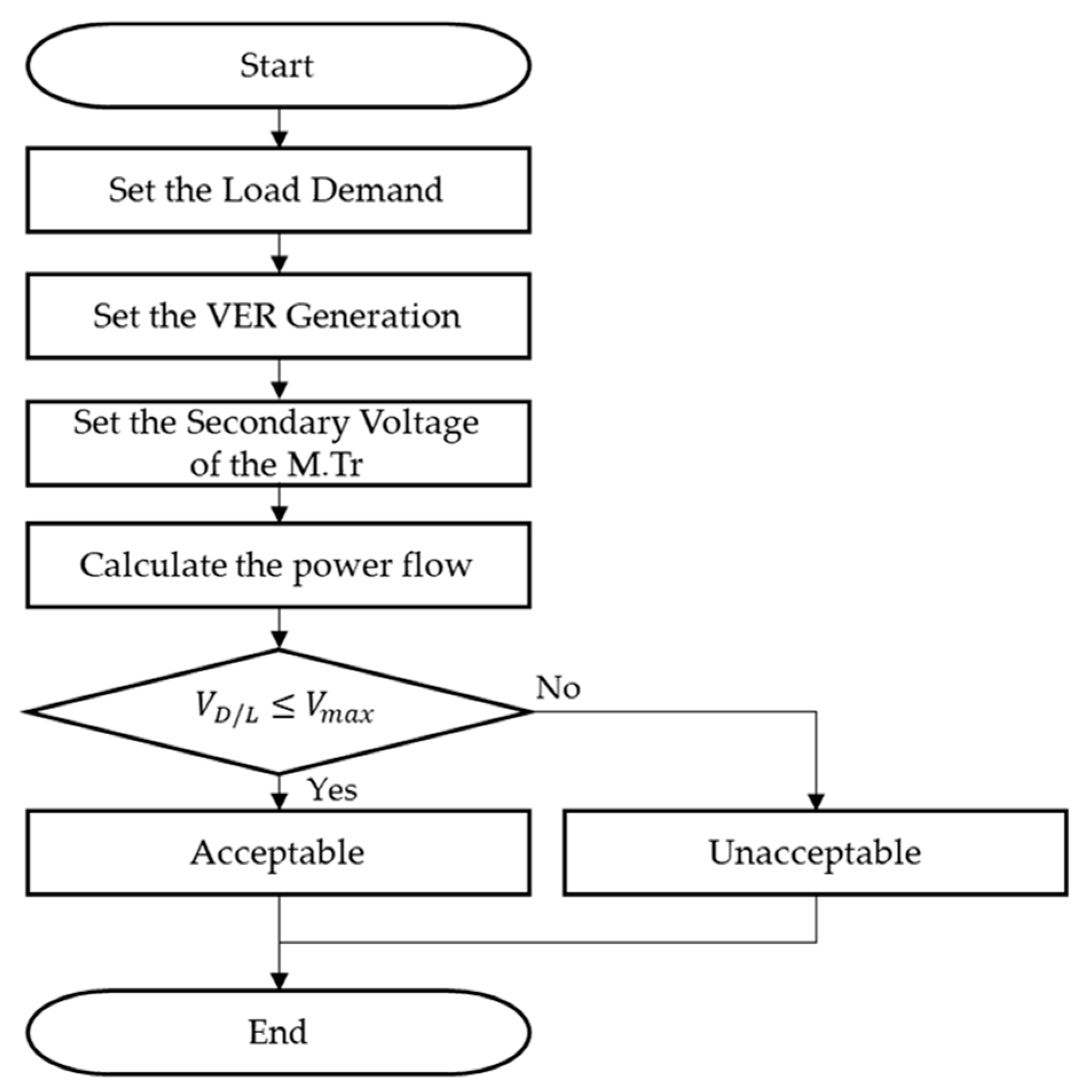
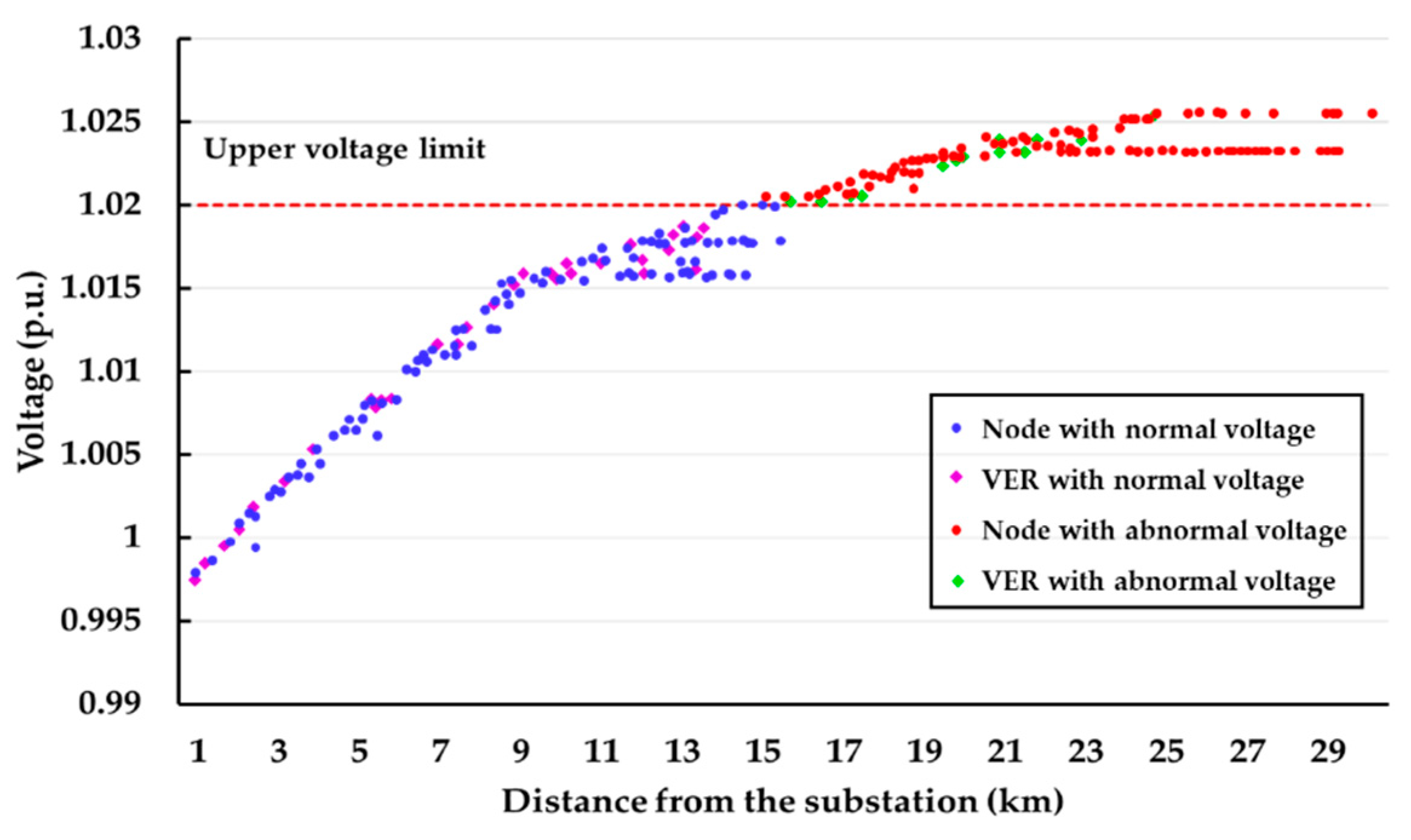




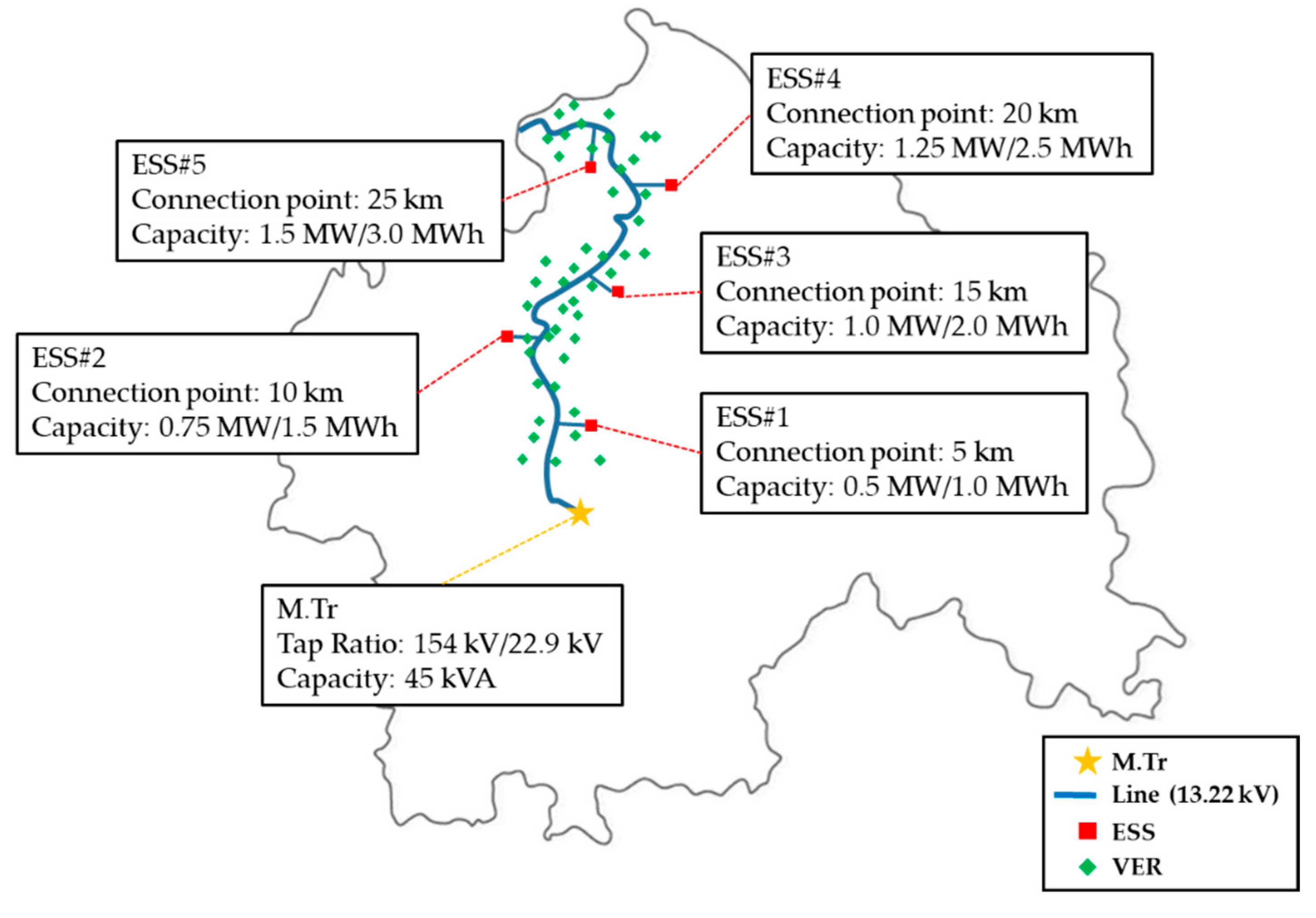
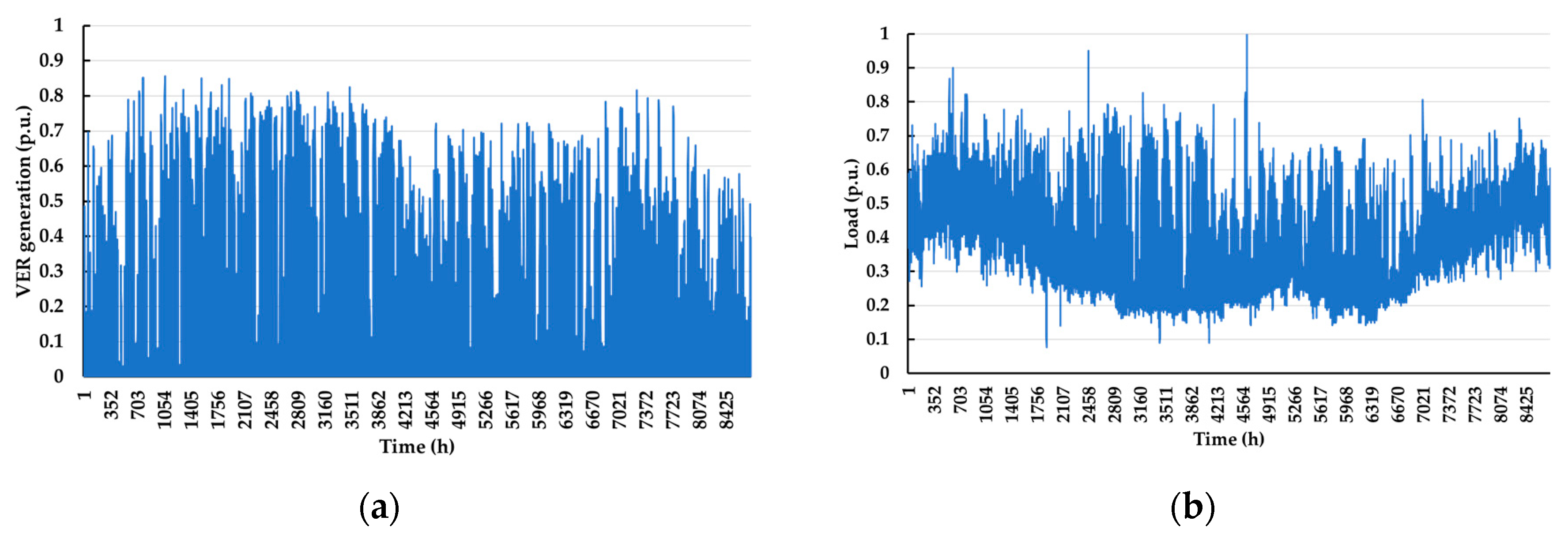

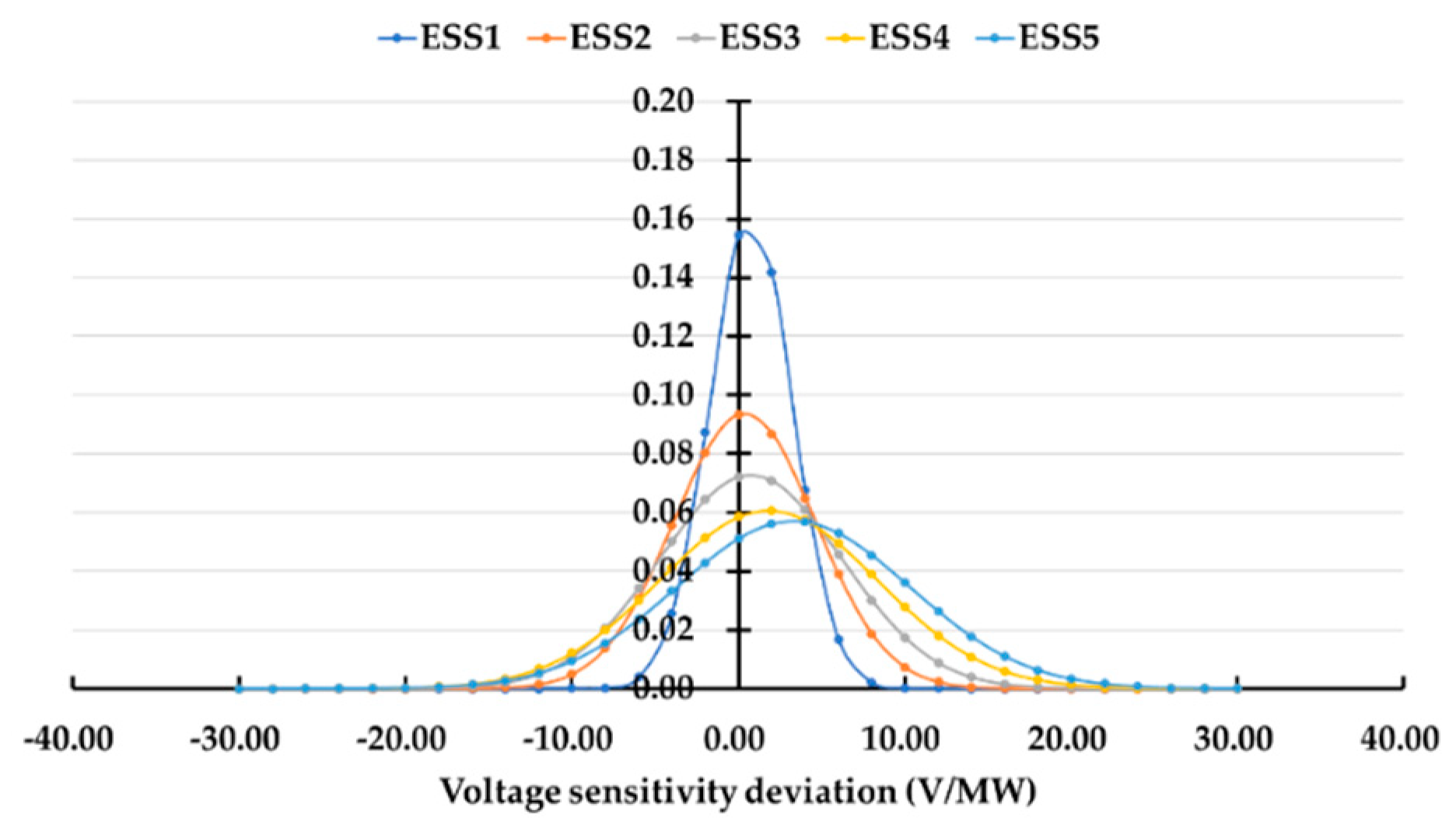



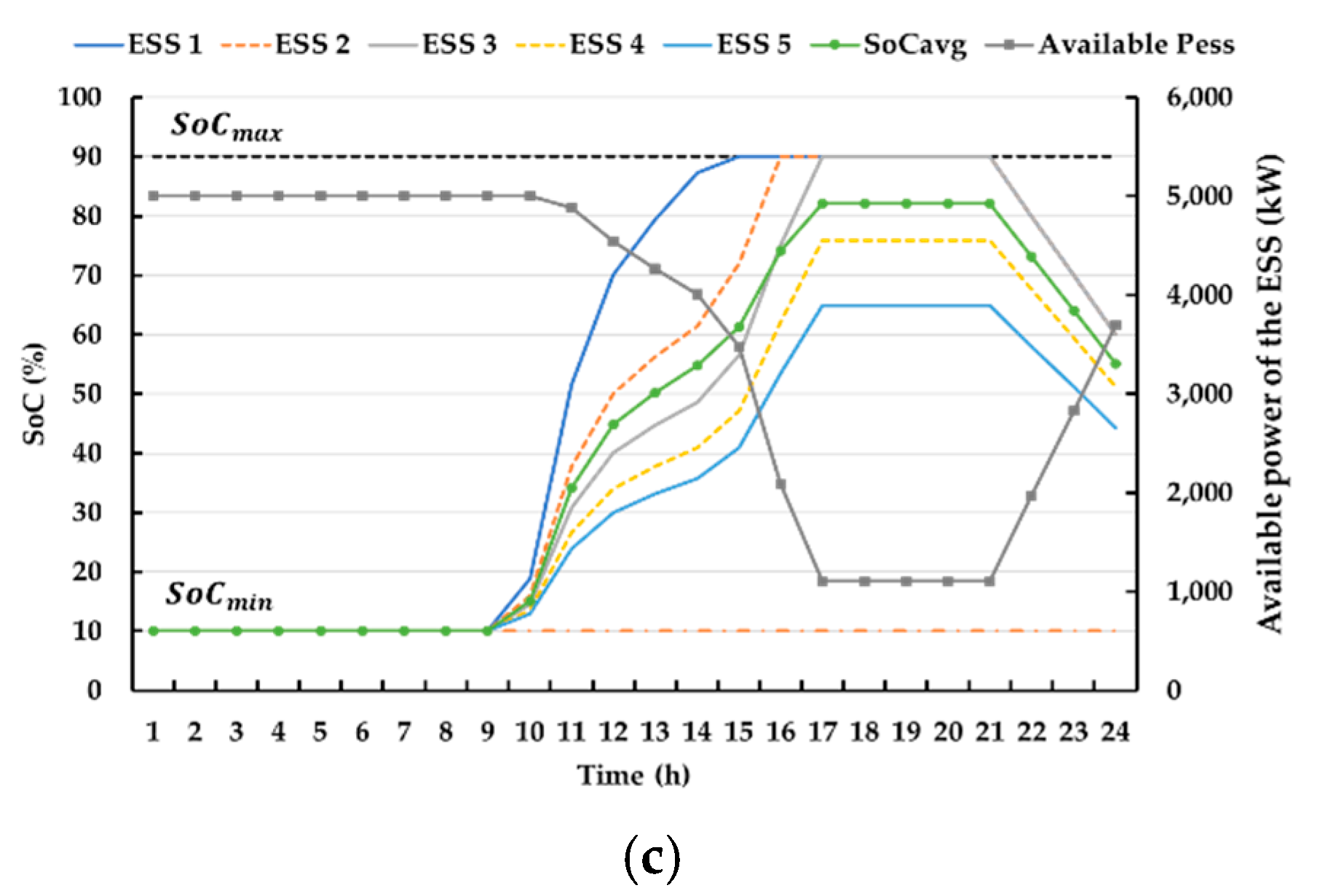
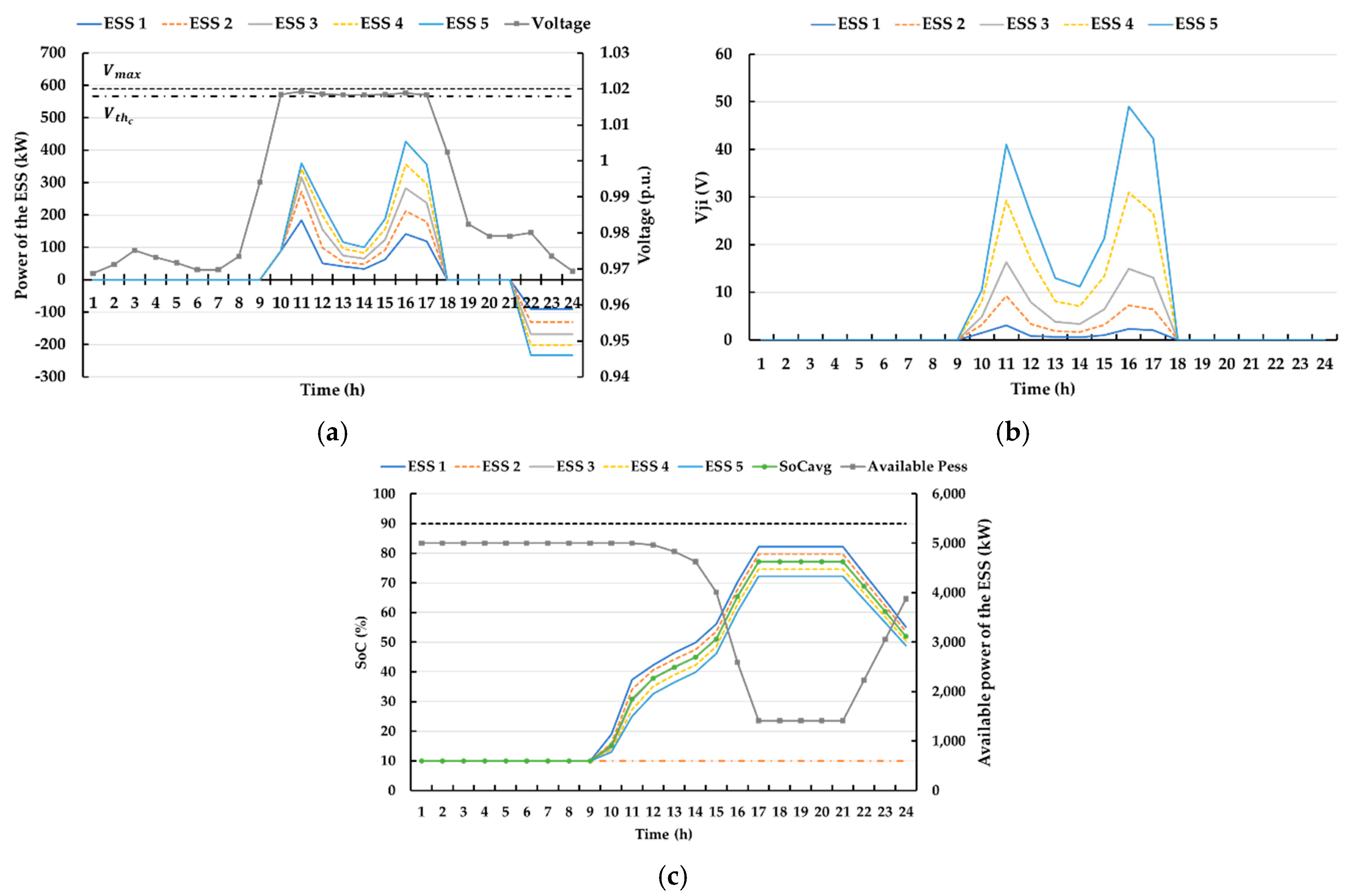
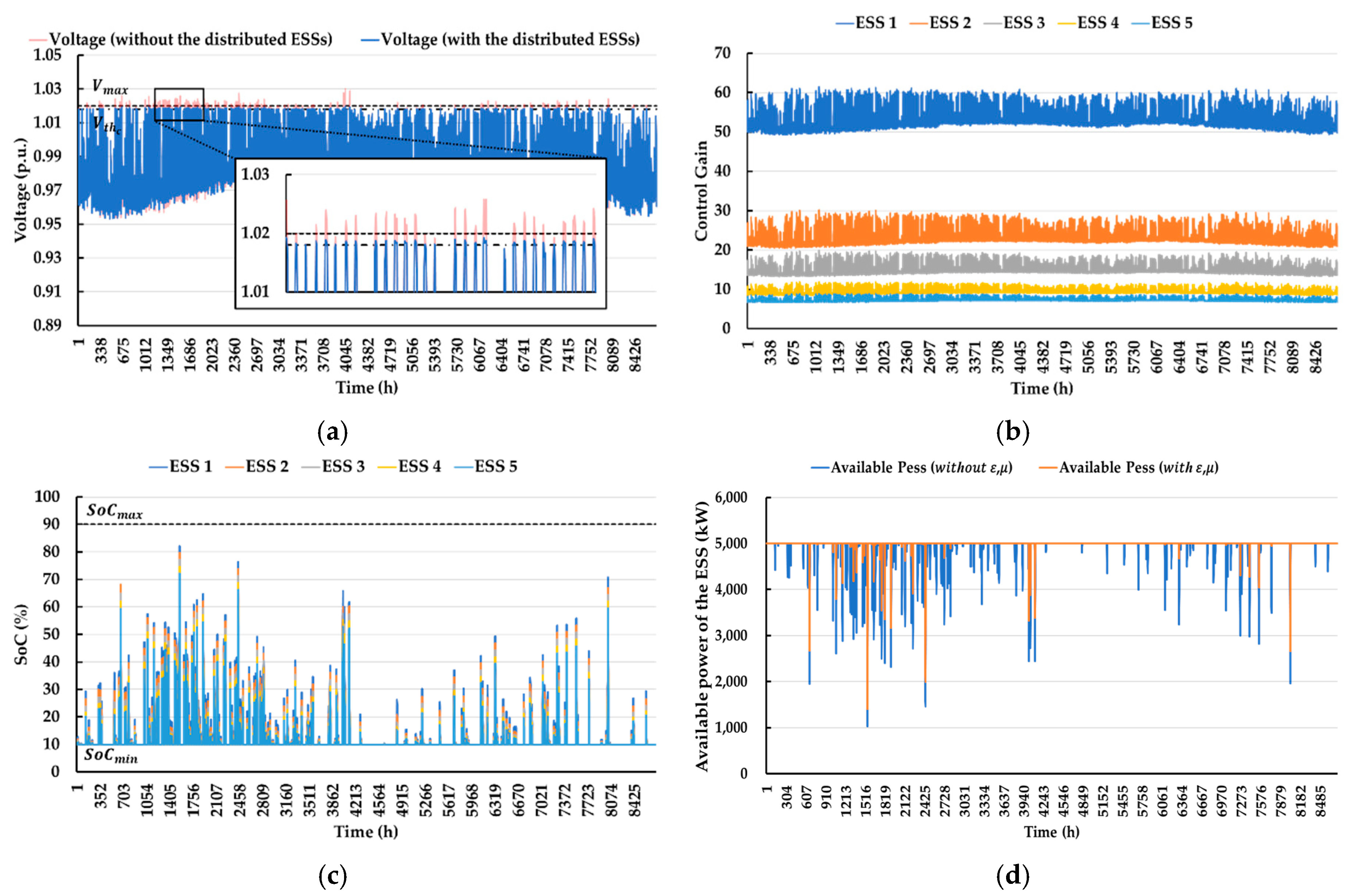
| Conductor | ||
|---|---|---|
| CNCV-W325 | 0.075 | 0.125 |
| AWOC-160 | 0.304 | 0.441 |
| AWOC-95 | 0.182 | 0.391 |
| Voltage Sensitivity | ESS 1 (V/MW) | ESS 2 (V/MW) | ESS 3 (V/MW) | ESS 4 (V/MW) | ESS 5 (V/MW) |
|---|---|---|---|---|---|
| Avg. | 0.74 | 0.35 | 0.72 | 1.79 | 3.29 |
| −6.67 | −12.43 | −15.73 | −17.91 | −17.71 | |
| 8.15 | 13.14 | 17.17 | 21.48 | 24.28 |
© 2020 by the authors. Licensee MDPI, Basel, Switzerland. This article is an open access article distributed under the terms and conditions of the Creative Commons Attribution (CC BY) license (http://creativecommons.org/licenses/by/4.0/).
Share and Cite
Noh, S.G.; Choi, W.Y.; Kook, K.S. Operating-Condition-Based Voltage Control Algorithm of Distributed Energy Storage Systems in Variable Energy Resource Integrated Distribution System. Electronics 2020, 9, 211. https://doi.org/10.3390/electronics9020211
Noh SG, Choi WY, Kook KS. Operating-Condition-Based Voltage Control Algorithm of Distributed Energy Storage Systems in Variable Energy Resource Integrated Distribution System. Electronics. 2020; 9(2):211. https://doi.org/10.3390/electronics9020211
Chicago/Turabian StyleNoh, Seung Gil, Woo Yeong Choi, and Kyung Soo Kook. 2020. "Operating-Condition-Based Voltage Control Algorithm of Distributed Energy Storage Systems in Variable Energy Resource Integrated Distribution System" Electronics 9, no. 2: 211. https://doi.org/10.3390/electronics9020211
APA StyleNoh, S. G., Choi, W. Y., & Kook, K. S. (2020). Operating-Condition-Based Voltage Control Algorithm of Distributed Energy Storage Systems in Variable Energy Resource Integrated Distribution System. Electronics, 9(2), 211. https://doi.org/10.3390/electronics9020211





